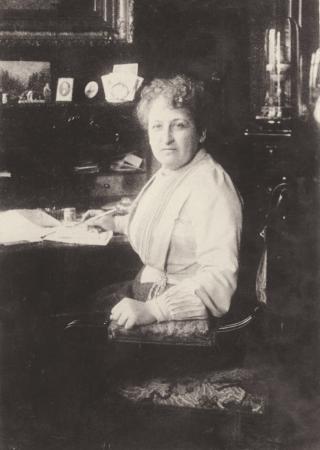This Saturday, on April 25, 2015, the Carnegie Foundation holds a special event that aims to enhance the visibility of women in the Peace Palace. Two years ago, during the centenary of the Peace Palace, Bertha von Suttner was the first women to be honored with a bust in the Great Hall. This year, we celebrate the Centenary of the Women's International League for Peace and Freedom (WILPF) and to mark this occasion, a new statue will be unveiled, that of Doctor Aletta Henriëtte Jacobs. With this bust, we turn the spotlight on Dr. Aletta Jacobs and her work for world peace.
By Ms. Jitske Zitman
In the Netherlands, Aletta Jacobs (1854-1929) is well known for being the first Dutch woman to graduate from university. She studied medicine at the University of Groningen among male students only. After her graduation, she registered as the first female general physician in Amsterdam. She later joined the Suffragette movement and became a fierce advocate for women’s rights. Her efforts were entirely successful and in 1919, Dutch women were finally granted the right to vote.
Suffragettes; Feminism; Pacifism
Whilst working on suffrage, Aletta acquired a widely international network via the International Women’s Suffrage Alliance (IWSA), which was founded in 1904. On her missions for a better world, Aletta sided with 'team Suffrage' which placed her in to an opposing position from world famous pacifist Bertha von Suttner. Both women met on several occasions and tried to persuade one another. Women, both Suffragists and Pacifists, were bound together in feminism the latter being rooted in the rejection of the rule of force by physically more powerful men. It was Aletta's firm belief that feminism and pacifism are inextricably linked. Nothing made this more clear than when World War I exploded over Europe on the August 4, 1914.
International Congress of Women, The Hague, 1915
It was in an appeal to put an end to these atrocities that Aletta Jacobs organized the International Congress of Women in The Hague in 1915. Courageous women from all over Europe and Northern-America ,committed to suffrage as well as to peace, travelled to The Hague, crossing through warzones and overcoming other obstacles in an effort to develop alternatives to war. Aletta stressed that they had NOT convened a 'Peace Congress' but rather a congress of women assembled to protest against war. Women united in the great ideals of civilization and progress; discussing their possible role in bringing about peace. Spirits of hope and camaraderie were great and much was accomplished*. Aletta's suffragist 'background' shone through in one of the resolutions: "women should be granted equal political rights with men."
Further Peace Work
After the proceedings took place**, Aletta was part of the delegation that traveled all over Europe to visit the national leaders of the warring countries, in an effort to promote mediation of the war. Another direct outcome of the Congress was the establishment of the International Committee of Women for Permanent Peace. Aletta and her secretary, Rosa Manus maintained the Dutch section of this Committee, publishing and dispersing the Pax International. These activities were transferred by the ladies to WILPF International in Geneva in 1919. In that same year, she travelled to Berlin to denounce the post-war famine and travelled to Siberia to expose to the world the gruesome POW-camps in the freezing cold. Her initiative to raise money for clothes for the prisoners was eventually handed to and carried out by the International Red Cross.
Aletta comes to the Peace Palace
Aletta did not attend the opening of the Peace Palace in 1913. International Congress of Women took place in the Haagse Dierentuin as the number of delegates was too large for the Peace Palace to accommodate. This Saturday 25th April 2015 Aletta finally arrives to her kindred spirits in the Peace Palace. Summing up Aletta's achievements for earning an honorary spot in the main Hall of the Peace Palace it can be said that she had an active role from the start of the developments of the Congress and within the peace movement. Her international political views led to the conviction that there is a direct and causal link between unlawfulness and war, as well as between justice and peace. She laid out the path for men and women alike, young and old, then and today to work for constructive peace.
I conclude with mrs Carrie Chapman Catt, of the IWSA who sent her best wishes to the International Congress of Women in these words: "I predict that your gathering will pass into history as the beginning of a great international woman's movement, (...) which will make its demand for the abolition of war so insistent, so impelling, that nations will be forced to heed its call." Her words were clearly foresightful. And we can see there is still a lot to be done. The Womens’International League for Peace and Freedom (WILPF) is ready for the next century baring Aletta's legacy.
Aletta Jacobs' bronze bust is made by artist Lia Krol, and is a gift of the Dutch section of WILPF to the Carnegie Foundation and every person committed to world peace through law and justice. For the unveiling ceremony, former Secretary General of WILPF, mrs Edith Ballantyne will hand over the bust to dr. Bernard Bot, president of Carnegie Foundation. In attendance of alderman for International Affairs is ms Ingrid van Engelshoven and Professor Dr. Mineke Bosch, biographer to Aletta Jacobs. The unveiling ceremony can be attended by invitation only. It is possible however to attend WILPF's Centenary Conference from 27th to 29th April 2015 in World Forum The Hague.
Register online: www.womenstopwar.org or at the ticket desk in the World Forum.
*Read more on the International Congress of Women here.
**For more on Aletta's role in the organizing committee, click here.
